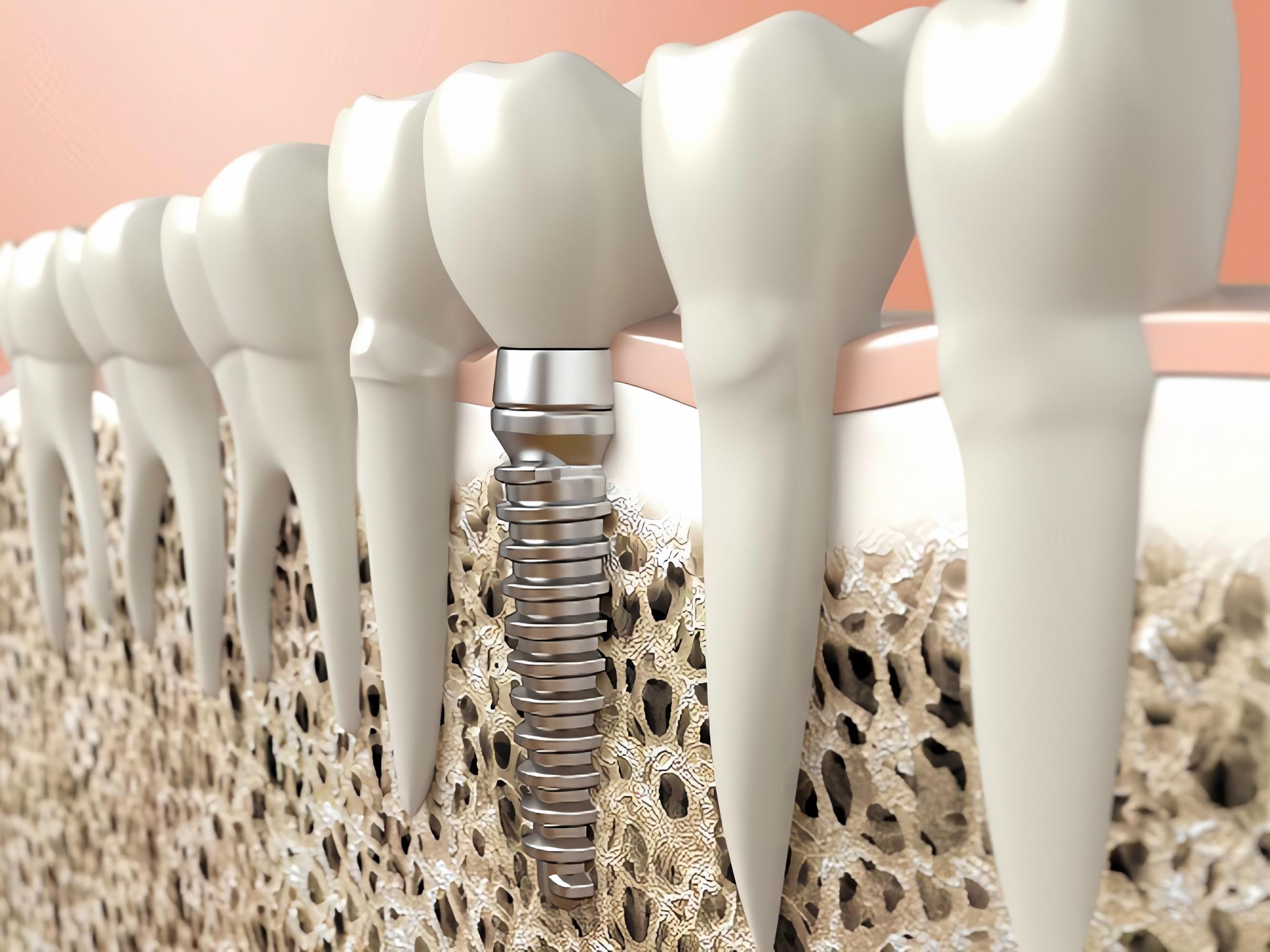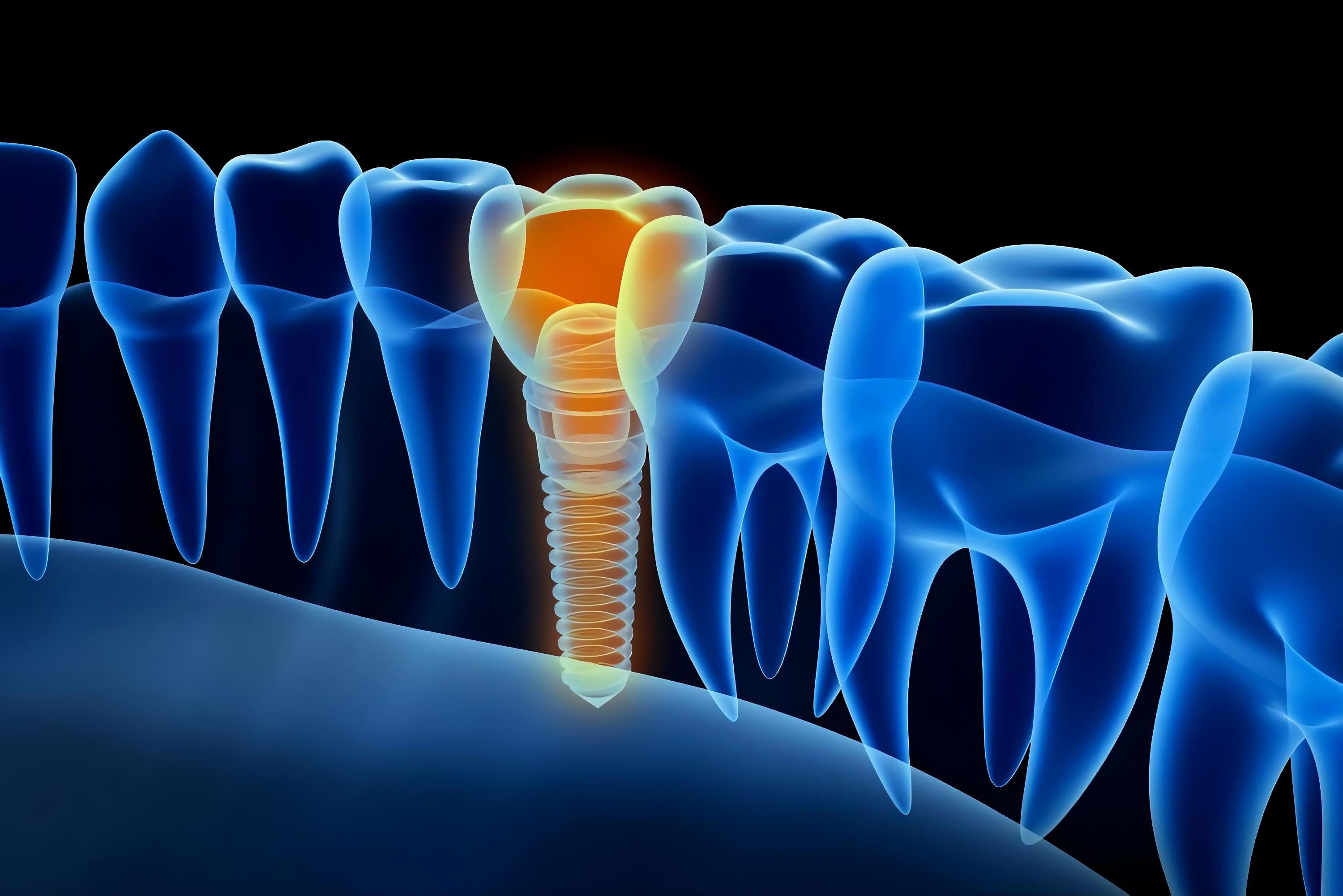Osteoporosis is a condition in which bone tissue is lost. As tissue is destroyed at a microscopic level, the bones become more fragile and can easily break. More recently, it has been discovered that there is a connection between osteoporosis and the condition of the teeth and jaw.
Osteoporosis symptoms
There are a variety of risk factors for osteoporosis, including low dietary calcium intake, activity level, body size, hormonal factors, and genetics.
When the bone density of the jaw decreases, various dental pathologies develop, which can lead to the loss of teeth. Prosthetics are needed to restore the functionality and aesthetics of the jaw system. Dental implants are the preferred option, because they are more secure, comfortable, and aesthetically pleasing than other tooth replacement options.
Read more about dental implants
Many osteoporosis patients wonder if dental implants are an option for them. Fortunately, having osteoporosis does not disqualify a person from getting implants. In fact, dental implants are often recommended for osteoporosis patients, because the implant stimulates the regeneration of bone tissue and increases bone density in the area.
Indications and contraindications
Dental implants are made of titanium, and are placed directly into the jaw bone, where they act as artificial tooth roots. A prosthetic tooth (crown, bridge, or denture) is attached to the implant. Implants can be used to replace just one tooth, a small segment of teeth, or even all of the teeth, and can be placed in both the upper and lower jaws.
Because it’s implanted directly into the jaw bone, a dental implant is very secure, and can be used for daily activities like chewing and speaking in exactly the same way that a natural tooth would. This makes implants more convenient and comfortable than other tooth replacement options. In addition, a dental implant stimulates the growth of the bone tissue around it, which helps to maintain the strength and integrity of the jaw bone.
There are certain cases in which patients may not be eligible to get dental implants. The decision about whether it’s appropriate to proceed is made by the doctor, using data from a CT scan. This is a 3D scan, which allows the doctor to see the condition of the jawbone from various angles and layer by layer. The doctor can thus evaluate the degree of disease development, bone atrophy, and mineral composition, to determine whether the patient’s jaw bone is able to support an implant. If not, then a bone graft can be considered. This is a procedure that strengthens the bone of the area in order to prepare it to receive an implant.
Certain factors are contraindications for dental implants, meaning that dental implants are not a good option for these patients. These include:
- tuberculosis;
- clotting disorders or other blood diseases;
- malignant tumors;
- bruxism;
- mental disorders;
- severe vascular and cardiac abnormalities;
- sexually transmitted diseases;
- abnormal bite;
- acute infections;
- exacerbation of chronic diseases;
- alcoholism or smoking (if the patient cannot give up cigarettes for a long period of time);
- pregnancy or lactation;
- exacerbation of chronic diseases;
- low level of immunity.
Some of these conditions are reversible, and dental implants will become an option for these patients after they are appropriately treated. We help our patients to access medical care in order. 
Implantation protocols for osteoporosis
Traditionally, the placement of a dental implant required several steps. After implantation of the titanium root, the patient would need to wait for several months before the artificial tooth was attached. More recently, techniques have been developed to allow for one-stage implantation, which permits patients to use their implants immediately. This is known as immediate loading, and it offers an instant aesthetic as well as functional restoration.
For those who have lost all of their teeth, we do not need to place a separate implant for every single tooth. Instead, a full denture can be supported on 4 to 6 implants. This is known as all-on-4 or all-on-6. In general, 4 implants are used for the lower jaw, while 6 are needed for the upper jaw. This is because the bone of the upper jaw is thinner, due to the presence of the sinuses just above. Because the bone is thinner, each implant must be shorter, and so more implants are needed to secure the full denture.
Here at our Ukrainian dental clinic MistoDent (Kharkov), our dentists are highly trained in immediate loading protocols. For these dental implant experts, there is no such a thing as an unfavorable bone condition. Our dentists are use specific techniques to place the titanium roots at an angle. This avoids trauma to adjacent structures such as the sinuses, and also can often avoid the need for bone grafting.
We have worked with many patients who have previously been told that their osteoporosis would prevent them from getting dental implants. Using the correct techniques can often make dental implants possible for osteoporosis patients. Although some patients do require bone grafting in order to get implants, others can avoid taking this extra step when the appropriate surgical techniques are used.
Download PDF of protocols: all-on-4 or all-on-6
Methods of implantation
There are both one-stage and two-stage protocols for the placement of implants. For most patients, a one-step protocol is preferable. The implants will be inserted at an angle. This allows the implants to be longer, which creates a larger surface area where the implant is in contact with the bone tissue. Ultimately, this leads to greater stability and security of the implants.
In the older two-stage technique, the implant is placed through an incision in the gum tissue, and then the gum is sutured closed. After a period of healing, which lasts an average of six months, the gum is reopened and the prosthetic is attached on top. The trauma to the gum from the incisions and sutures is considerable. This method almost always requires that the patient undergo bone grafting first, which adds additional time to the overall implant placement process.
By contrast, one-stage treatment protocols allow the teeth to be restored much more quickly. The method is minimally invasive, using micro punctures in the gum to introduce the artificial tooth root rather than larger incisions. As a result, this procedure is more comfortable for the patient and the recovery period is easier.
Methods of single-stage implantation:
- Implant placement can be performed immediately after tooth extraction. Just one surgical session is necessary both to extract the damaged tooth and place the implant.
- When restoring a group of missing teeth or a full row, we often use basal implants. These are designed to extend deeper than a traditional implant, so that they can be secured in the denser and stronger portion of the jaw bone. This allows one implant to support multiple prosthetic teeth.
- Treatment of full adentia, or a patient who is missing all of their teeth. For these patients, we use All-on-4 or All-on-6 protocols.
Make an appointment for implantation All-on-6
The decision about which method of implantation to use will be made by your dentist, based on the information collected as part of the diagnostic process. We will discuss our treatment decisions with you, so that you’re fully informed about how your procedure is being performed and why.
Stages of implantation
One-stage implantation requires just a few steps. While the older two-stage method of implant placement is very time-consuming, the one-stage method can be completed in only a few days. This period includes diagnosis, surgery to install the titanium roots, and attachment of the prosthetics.
Preparation for implant placement
At the initial appointment, the doctor collects a complete medical history, examines the patient’s gums and teeth, and conducts a CT scan. The patient also undergoes blood and urine tests to rule out any possible contraindications. A general practitioner's authorization may be required, in order to ensure that the patient doesn’t have any medical conditions that would make implants unsafe for them.
If the patient is considered to be a good candidate for dental implants, then a thorough professional cleaning is performed. If any dental issues (such as cavities or gum disease) are discovered, then these will be treated.
The dentist will next perform a diagnostic evaluation, in order to choose the restoration method and the implant system. If full adentia (a patient who is missing all of their teeth) is treated using one-step protocols, 3D modeling of the result is performed, and surgical templates are printed.
Performing the implantation
The implantation procedure itself is performed in three steps:
- Local anesthetics are used to numb the area.
- The area is prepared to receive the titanium root.
- The implant is placed into the bone.
If a tooth needs to be extracted, an implant can generally be placed at the same time. We can perform both procedures in a single surgical session.
The final step is prosthetics
For those who are having an implant placed at the same time as a tooth extraction, the prosthesis can generally be placed on the same day.
Patients who are having all of their teeth extracted will be given immediate dentures, which will be worn for a few days. Temporary crowns will be placed within three days. Although they are labeled “temporary,” these crowns are not flimsy; they're high-quality and can last up to several years. The permanent dentures will be placed after a minimum of six months. This time is necessary to allow for healing and adjustment of tissues, so that the permanent denture will continue to fit well for years into the future. If it’s fabricated and placed too soon, it may no longer fit well after the healing process is complete.
For some patients, we use delayed loading. This means that the prosthetic restoration is made after the implant has been given time to fully take root and integrate into the jaw bone. In this case, a permanent crown is placed immediately.
Rehabilitation period after implantation with osteoporosis
The success of the implantation procedure depends on how well the patient follows the after care instructions given by their dental team. Some patients will be prescribed antibiotics; it’s crucial to take these as directed, and to finish the full course of the medication. Pain and swelling can be managed with oral medications and cold compresses. Meticulous oral hygiene (brushing and flossing) helps to prevent infection; make sure to use a toothbrush with soft bristles, to avoid causing irritation to the oral tissues while they are healing. Eat soft foods at a moderate temperature (not too hot or too cold) so that you don’t damage the healing tissues. Avoid raising your body temperature by going in a sauna or hot bath, or by sunbathing; this can increase swelling and interfere with healing.
It’s crucial to avoid smoking during the process of implant integration. Various chemicals in cigarette smoke interfere with blood flow and can prevent an implant from integrating successfully into the jaw bone, leading it to become loose and fall out. Patients must abstain from smoking for at least 4-6 months after their implant placement. 
Prevention of osteoporosis in dentistry
Oral hygiene is very important to keep your teeth and gums healthy, especially if you have early signs of osteoporosis. Ensure that you brush your teeth after each meal. If plaque (bacterial growth) is not removed from the teeth promptly, it hardens and turns into tartar, which is much more difficult to remove. This causes inflammation of the gum tissues, which leads to periodontitis (gum disease). Over time, the inflammation can lead to bone loss in the jaw, and can damage the ligaments that hold the teeth in place, causing them to fall out. This is why oral hygiene is so crucial.
If you have osteoporosis, it’s important to see a doctor about your condition. You’ll get recommendations to treat the condition and reduce the likelihood that it will progress, which helps to avoid the serious consequences that osteoporosis can cause. If you’ve already lost teeth, then implants can still be an option, even if you have osteoporosis.
Cost of dental implants in Ukraine
Dental implants are the preferred form of treatment for almost every patient who is missing one or more teeth. However, many patients are understandably concerned about the cost of dental implants. In places like the UK, Europe, and the US, dental implants can be very expensive. Some patients may unfortunately find that they cannot afford this form of treatment.
Many patients from the UK, Europe, the US, and other parts of the world fly to Ukraine to get European-quality dental treatment at affordable prices. The cost of dental implants in Ukraine is significantly lower than in many other countries. Even with the added costs of a flight and lodging, you will still save a lot of money compared with getting your treatment at home.
Here in Ukraine, you won’t sacrifice the quality of your treatment at all. Our Ukrainian dentists are experts with extensive experience and advanced training in the placement of dental implants, and they work only with the latest technology and European materials of the highest quality. Because of the lower cost of living here in Ukraine and the favorable exchange rates, we’re able to offer world-class treatment at affordable prices.
| Implants manufacturer | Price all-inclusive |
|---|---|
| Straumann implant (Swiss production) | 800 euro |
| In-Kone Tekka implant (Swiss production) | 535 euro |
| Mis implant (Israel) | 490 euro |
| Alfa Bio implant (Swiss production) | 400 euro |
| Simple Swiss implant (Swiss production) | 380 euro |
| Nobel Biocare implant (Swiss production) | 800 euro |
The average survival rate of implants
| Implants manufacturer | Survival rate |
|---|---|
| Alpha Bio (Israel) | 99,6% |
| Osstem (South Korea) | 99,2% |
| Implantium (South Korea) | 98% |
| Astra (Sweden) | 98% |
| MIS (Israel) | 97% |
| Nobel Biocare (Switzerland) | 99,7% |
MEDICAL DISCLAIMERThis content is for informational and educational purposes only. It is not intended to provide medical advice or to be a substitute for such advice or treatment by a personal physician. All readers of this material are advised to consult their own physicians or qualified health care professionals. UAmedTOURS is not responsible for the possible health consequences to any person or persons reading or following the information contained in this educational content. All readers of this content, especially those who take prescription or over-the-counter medications, should consult their physicians before making any changes in their diet, lifestyle, taking pills, or other facts that may affect your physical and psychological health.









